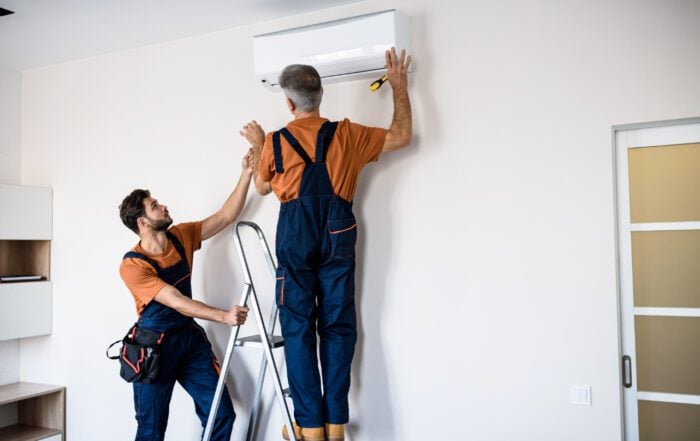There are probably many things on the forefront of your mind. But if you’re a homeowner, there’s going to be one thing that sticks out in particular: “How can I save?” That often encompasses saving on utility bills and lowering energy consumption. We’ve covered a wide variety of ways to save, including adding a geothermal unit to your home’s system, fitting your home with retrofit systems, and even signing up for a regular maintenance program. But there are also ways to save that you probably don’t think about – including landscaping. Sometimes “going green” actually means going green.
Windbreaks
Winter in our area is a challenge for energy savings. Dreaded lake-effect snow, (which particularly pummels communities to the east) and strong winds can put a lot of demands on even the toughest and most efficient heating system. Cut some of your costs by landscaping with a windbreak.
Windbreaks are collections of tall foliage – typically trees, but sometimes shrubs do the trick – placed near a home or building to reduce the effect wind has on its heat loads. They work by “breaking,” or redirecting, the flow and speed of the wind; this reduces the impact of the wind chill and thus lowering the need to heat the home as much.
A well-designed windbreak can significantly affect the wind-chill temperatures as well as redirect drifting snow. Evergreens and shrubs are especially suited to this kind of work when planted north and northwest of your house. These work particularly well because their mature heights are ideal for wind blockage with the height of typical homes. They’re also thick enough to stop the largest flow of wind and have vegetation that spreads all the way to the ground.
In addition to landscaping large lines of trees and shrubs, planting smaller hedges and vines next to a building can also reduce airflow, creating more insulation for the home.
Windbreak Landscaping Tips:
- The best windbreak density for the side of the home most affected is about 60 percent. So consider using evergreen trees such as blue spruce and white spruce. A higher density can create a vacuum on the side protected from the wind.
- Use more than one species of tree when planting your windbreak. A variation in height will create rigged edges.
- If you’re using solely evergreen trees, 2-3 staggered rows will create enough of a barrier while still looking natural. However, if you’re using more deciduous trees and shrubs, you’ll need another row or two to have the same effect since they lose their leaves during the fall and winter months.
- Plant your windbreaks away from the home or building. Rule of thumb: plant them at a distance 2-5 times the mature height of the tree. So if you use blue spruces that reach about 45 ft. high in domestic situations, plant them 90-225 ft. away.
- As a resident of Ohio, you’ll want to plant your windbreaks along the north and west sides of your home to protect it from cold winter winds. Pair that with lower shrubs along the outside of the breaks to cut down on snowdrifts.
Strategic Landscaping
An often overlooked method of saving money in home heating and cooling is the use of strategic landscaping. By strategically planning the landscaping around your house, you can assist your already energy-efficient HVAC equipment in saving you money.
Energy.gov has a great infographic to guide you through landscaping your home to be the most energy efficient it can be.
Here in Ohio, we live in what is called the “Cool Region.” That means that we need to landscape our homes to help the sun reach south-facing windows in the winter and shade the southern and western side of the house in the summer.
Strategic Landscaping Tips:
- Plant deciduous trees and shrubbery to the south. They’ll pull in a large portion of the summer heat while still allowing the cool breezes to reach your home.
- Have a patio or deck area? Take advantage of shade provided by vines with trellises and taller shrubs.
- If you want to cool down warm winds sweeping into your yard before it reaches your home, try planting groundcover plants like ivy.
- Use mulch throughout your landscaping to keep plant roots cool and water from evaporating into the air too quickly. And that keeps your plants healthy, which means they can continue to provide shade and wind-blocking.
Throwing Shade
Ohioans typically endure a hot, humid summer. You can reduce the strain on your cooling system by adding shade to both the house and the heat-reflecting surfaces around it such as walkways and driveways. Large, deciduous trees provide aesthetics and are capable of shading the home. When planted on the south side of your house, they can affect the temperature in a home by close to 10 degrees by blocking the hot afternoon sun. Although many trees are slow growing, the long-term investment is well worth the effort.
Landscaping with Shade Tips:
- Here in Ohio, we don’t need to shade homes in the winter season. So use deciduous trees rather than evergreens near the house.
- Use trees with high, wide limbs and leaves on the south side of the home to amplify roof shading. On the western side where there’s low, afternoon sun, use trees that spread closer to the ground. However, if you have roof-mounted solar panels, particularly on the southern side of your house, avoid planting trees in that area as they’ll block out the much-needed sun in the winter.
- Planting a tree on the west side of the home can reduce your energy statements by 3% in just a few years and continues to lower them over time. And placing three trees around the home can lower energy consumption by up to 30%.
- A quicker shade solution is to construct a trellis and plant train-climbing vines like we suggested above for your deck or patio. Choose flowering varieties for a pleasant aroma and color as a bonus.
Fall is coming soon, and it is the best time to plant your shade trees and windbreaks. Contact Stack Heating & Cooling for information on their “green” options to get the most out of your beautifully landscaped home.
Have Any Questions?
If this is an emergency please call 440-937-9134.
Otherwise, please feel free to call us or submit this form to schedule an appointment for service or request an estimate. We will contact you shortly!



